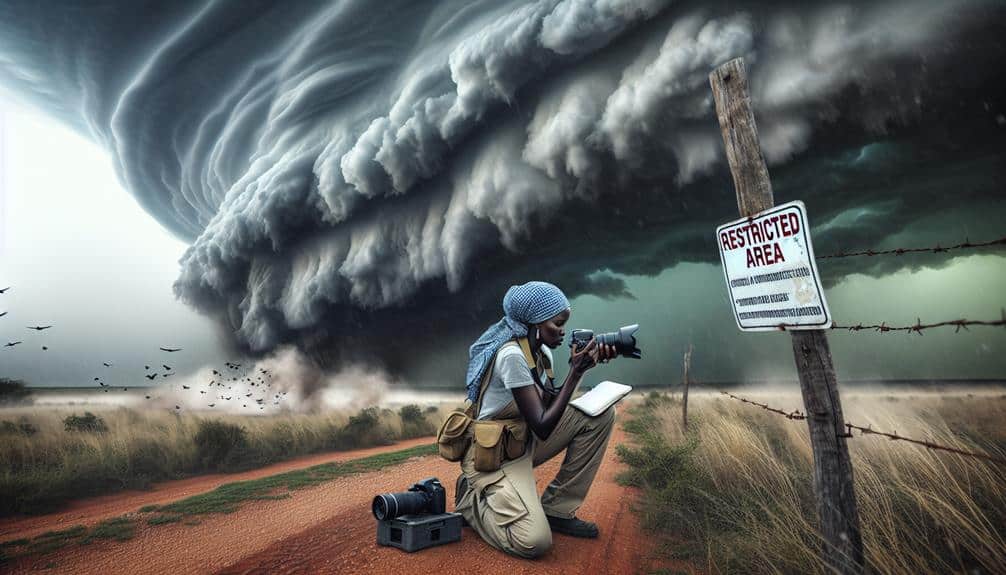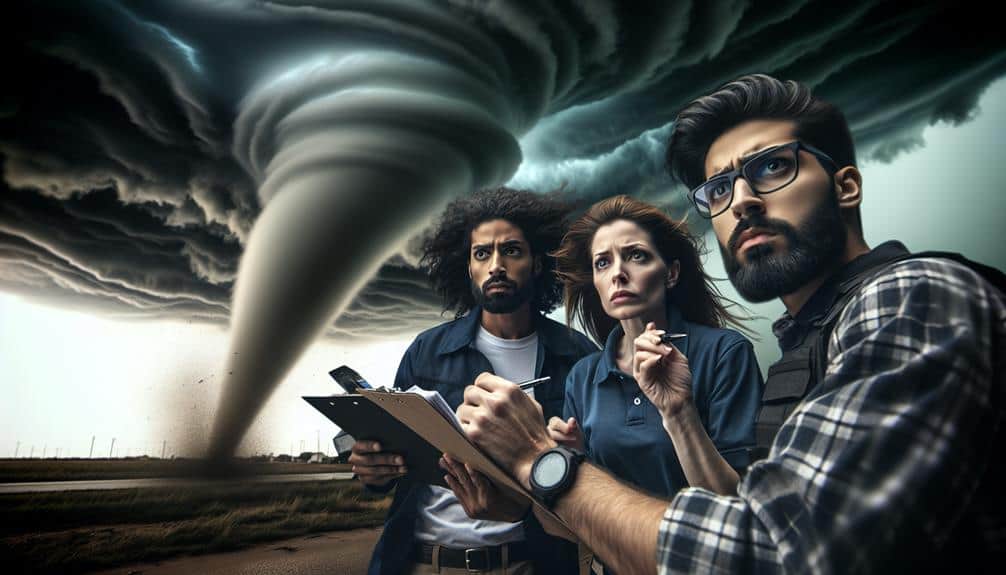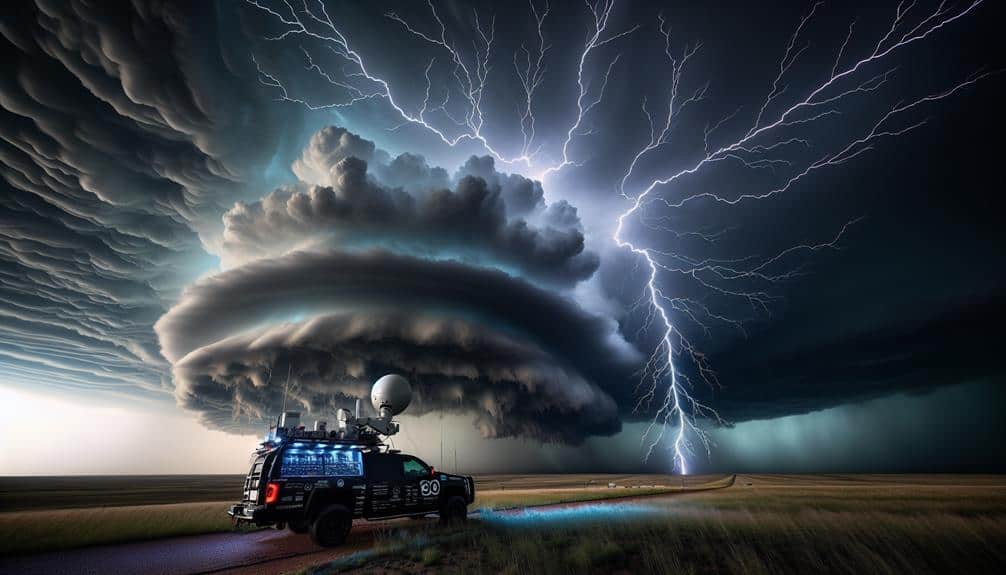In storm chasing endeavors, we guarantee accountability by implementing strict safety protocols, utilizing real-time data analytics, and using advanced meteorological tools like Doppler radar systems. We maintain secure and efficient communication channels, deploy high-speed data transfer systems, and conduct regular training and drills. By considering environmental impacts and adhering to legal and ethical standards, we optimize routes, minimize disruption, and ensure adherence to regulations. Collaborations with various entities, from academic to government sectors, enhance our data analysis capabilities and forecasting techniques. Learn how these measures interplay to create a thorough accountability framework.
Key Points
- Implement robust safety protocols, including real-time data analysis and emergency response training.
- Establish clear communication channels using encrypted frequencies and secure platforms for real-time information sharing.
- Adhere strictly to legal regulations and obtain necessary permits for all storm chasing activities.
- Conduct regular safety drills and briefings to ensure preparedness and accountability among all team members.
Adhering to Safety Protocols
When storm chasing, we must rigorously adhere to established safety protocols to mitigate risks and guarantee the well-being of all participants. Implementing robust safety measures involves a multi-layered approach, integrating real-time data analysis, weather pattern monitoring, and predefined escape routes. Our commitment to these protocols isn't just about following rules; it's about ensuring our freedom to explore extreme weather safely.
We begin by equipping ourselves with advanced meteorological tools, including Doppler radar systems and satellite imagery, to anticipate storm movements accurately. These tools enable us to make data-driven decisions, minimizing exposure to hazardous conditions. Additionally, each team member undergoes extensive training in emergency response, ensuring readiness for any unforeseen scenario. This includes first aid certification and familiarity with communication devices like satellite phones and emergency beacons.
Real-time coordination is essential. We establish a command center that continuously monitors our position relative to the storm, providing instant feedback and updates. Regular drills reinforce our preparedness, empowering us to act swiftly and decisively.
Transparent Communication Practices
How can we guarantee clear communication practices that improve both safety and efficiency in our storm chasing endeavors?
First, we must establish strong channels for real-time information sharing. Utilizing encrypted radio frequencies and secure digital platforms guarantees that our communication remains both transparent and accountable. By doing so, we enable all team members to receive accurate, timely updates, which is vital for quick decision-making and minimizing risks.
Stakeholder engagement is another key aspect. We need to keep meteorologists, emergency responders, and local authorities in the loop. By maintaining open lines of communication, we foster transparency and trust. Regular briefings and debriefings can help make certain that everyone is on the same page, reducing misunderstandings and enhancing our collective situational awareness.
Moreover, we should employ advanced analytics to monitor our communication systems. Real-time data analytics can flag any lapses in communication transparency, allowing us to address issues proactively. This data-driven approach makes sure that our operations remain efficient and accountable.
Data Sharing and Collaboration
Let's focus on the critical aspects of data sharing and collaboration in storm chasing efforts.
By utilizing real-time data exchange and open-source platforms, we can enhance the accuracy and timeliness of our findings.
Additionally, collaborative research efforts will guarantee a more thorough understanding of storm dynamics and improve predictive models.
Real-time Data Exchange
Effective real-time data exchange is crucial for storm chasers to enhance situational awareness and ensure coordinated efforts during severe weather events. To achieve this, we must focus on data accuracy and communication efficiency.
Accurate data serves as the backbone of our operations, ensuring that the information we share is reliable and actionable. By utilizing advanced meteorological instruments and algorithms, we can refine our data collection methods, minimizing errors and discrepancies that could otherwise jeopardize our missions.
Communication efficiency is equally essential. We rely on seamless, high-speed data transfer systems to disseminate critical information in real time. This involves leveraging satellite communication, mobile networks, and specialized weather monitoring software to guarantee that all team members receive updates instantaneously.
Efficient communication protocols allow us to make rapid, informed decisions, reducing the risk of misinterpretation and enhancing our collective response to evolving storm conditions.
We also use data-driven strategies to optimize our routes and positioning. Real-time mapping and predictive analytics enable us to stay ahead of severe weather patterns, maximizing both safety and observational opportunities. By prioritizing data accuracy and communication efficiency, we can effectively navigate the complexities of storm chasing, all while maintaining a high degree of operational freedom.
Open-source Platforms Usage
By leveraging open-source platforms, we can facilitate seamless data sharing and collaboration among storm chasers, meteorologists, and researchers, enhancing the collective understanding and response to severe weather events. Open-source platforms allow us to integrate diverse datasets, utilizing technology advancements to create all-encompassing models of storm behavior. This integration is pivotal for analyzing real-time data, historical records, and predictive algorithms, thereby enabling more accurate and timely decision-making.
We've seen significant progress in data sharing protocols that improve the quality and accessibility of meteorological information. Open-source repositories, such as GitHub and OpenWeatherMap, provide a collaborative environment where data can be uploaded, modified, and retrieved by anyone involved in storm chasing endeavors. This transparency not only democratizes access to critical information but also accelerates the pace of innovation and discovery.
Moreover, technology advancements in machine learning and AI can be effectively harnessed through these platforms to refine predictive models. By pooling our collective insights and resources, we can deploy more advanced analytical tools, enhancing our ability to anticipate and mitigate the impacts of severe weather. Ultimately, the synergy created through open-source platforms guarantees that our community remains agile, informed, and prepared.
Collaborative Research Efforts
Collaborative research efforts, anchored in robust data sharing and seamless collaboration, are crucial for advancing our understanding and predictive capabilities of severe weather phenomena. When we partner with academic institutions, government agencies, and private sector entities, we can leverage diverse expertise and technological resources. This network of research partnerships enhances our data analysis capabilities, allowing us to synthesize vast amounts of information from field observations and sophisticated forecasting techniques.
By pooling our data, we can identify patterns and anomalies more accurately. For instance, real-time data sharing from multiple storm chasers provides a thorough picture of a storm's behavior, which is vital for improving predictive models. Integrating these datasets enables us to refine our forecasting techniques, making them more reliable and timely.
Moreover, collaboration fosters innovation. When we exchange ideas and methodologies, we push the boundaries of what's achievable in storm research. This collective effort not only enhances our understanding of severe weather but also underscores the importance of accountability in our endeavors.
Environmental Impact Considerations
When evaluating the environmental impact of storm chasing, we must rigorously analyze the carbon footprint generated by vehicle emissions and equipment usage. Our vehicles, often modified for durability and safety, consume significant amounts of fuel, contributing to greenhouse gas emissions. A 2019 study indicated that an average storm chase vehicle emits approximately 4.6 metric tons of CO2 annually. This figure underscores the necessity for efficient route planning and possible integration of hybrid or electric vehicles to mitigate our carbon footprint.
Another critical area is wildlife preservation. Storm chasers frequently operate in rural regions, which are habitats for various species. Our presence can disrupt local wildlife, affecting their natural behaviors and breeding patterns. Research by the National Wildlife Federation highlights that even short-term human activity can lead to long-term ecological consequences.
To mitigate this, we can adopt practices like minimizing noise pollution and staying on established roads to reduce habitat intrusion.
Legal and Ethical Compliance

Ensuring legal and ethical adherence in storm chasing requires us to meticulously follow local regulations and ethical guidelines to safeguard both public safety and our professional integrity. Compliance monitoring is essential for guaranteeing our activities align with established legal obligations. By systematically tracking and documenting our adherence to regulations, we can readily demonstrate accountability measures in place.
Our ethical standards shouldn't only encompass respect for private property and local communities but also prioritize the minimization of interference with emergency services. Data-driven approaches enable us to evaluate our impact on various stakeholders, ensuring our actions remain within permissible boundaries.
Legal obligations, such as obtaining necessary permits and adhering to traffic laws, form the bedrock of our operations. Effective accountability measures, such as routine audits and peer reviews, further reinforce our commitment to legal and ethical compliance.
We must also be vigilant about evolving regulations and be prepared to adapt swiftly. This proactive stance ensures that our storm chasing endeavors remain both legally sound and ethically responsible. By focusing on precise compliance monitoring, we uphold our integrity while pursuing the freedom to explore nature's most formidable phenomena.
Community Engagement and Education
By involving local communities and providing educational outreach, we can cultivate a deeper comprehension of storm chasing's scientific value while promoting safety and preparedness.
Our outreach programs aim to enhance public awareness through data-driven educational workshops that cover meteorological basics, storm safety protocols, and the significance of timely information dissemination.
Community involvement plays a pivotal role in this initiative. We conduct surveys and gather feedback to customize our educational content to the specific needs and concerns of different localities. This participatory approach guarantees our workshops are pertinent and impactful.
For example, in areas with a high occurrence of tornadoes, we highlight early warning systems and evacuation procedures.
Analytical data indicates that areas with strong community engagement and education programs experience a statistically notable reduction in storm-related casualties. By utilizing these insights, we can refine our outreach strategies for optimal effectiveness.
Our objective is to empower individuals with the knowledge and resources they require to make informed decisions. This freedom of choice, supported by scientific literacy, not only enhances individual preparedness but also fortifies community resilience as a whole.
To summarize, our integrated approach to community involvement and education is fundamental for advancing both public safety and the scientific understanding of storm chasing.
Frequently Asked Questions
How Financially Viable Is Professional Storm Chasing as a Career?
We must assess professional storm chasing's financial viability by analyzing income stability and job security. Data shows fluctuating income and limited job security, making it less appealing for those desiring financial consistency and long-term career prospects.
What Is the Demographic Profile of Most Storm Chasers?
We usually observe a gender distribution skewed towards males, with an age range of 25-45 years. Most storm chasers have a background in meteorology or related sciences, mainly hailing from regions prone to severe weather.
How Can Amateur Storm Chasers Get Started in the Field?
To get started in storm chasing, we should dive headfirst into training courses to gain experience. Ensuring safety precautions, equipment readiness is essential. With the right preparation, we'll experience the thrill of nature's wildest storms safely.
What Equipment Is Essential for Successful Storm Chasing?
For successful storm chasing, we need safety gear and reliable communication. Vehicle modifications and advanced technology are essential. Equipping ourselves with GPS, weather radar, and durable vehicles guarantees we stay safe and collect accurate data.
Are There Any Specific Certifications Required for Storm Chasing?
Are there any specific certifications required for storm chasing? While formal certifications aren't mandatory, training requirements and safety regulations are essential. We need to understand meteorology, follow safety protocols, and use advanced technology to guarantee our safety.


